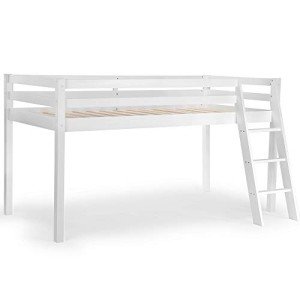Where Will Bunk Beds Children's Be 1 Year From What Is Happening Now?
The Ultimate Guide to Bunk Beds for Children: Safety, Styles, and Benefits
When it comes to styling a kid's room, moms and dads typically face the double difficulty of making the most of space while ensuring convenience and functionality. Bunk Beds For Teenagers have actually become a popular solution that attends to these needs, using not simply sleeping arrangements but likewise adding to a space's aesthetic. In this extensive guide, we will delve into different elements of children's bunk beds, focusing on their advantages, safety functions, styles, and considerations for parents contemplating this purchase.
Tabulation
- Benefits of Bunk Beds
- Safety Features to Consider
- Kinds Of Bunk Beds
- Design and Style Options
- Upkeep Tips
- Frequently Asked Questions (FAQs)
1. Benefits of Bunk Beds
Bunk beds use numerous advantages for kids and their parents. Here are some key advantages:
Space-Efficiency: Bunk beds are an outstanding solution for smaller sized spaces. By stacking one bed on top of another, more flooring space is offered for play, storage, or research study areas.
Affordable: When children share spaces, bunk beds can reduce the requirement for acquiring 2 separate beds, hence saving money.
Fosters Social Interaction: Bunk beds can help brother or sisters or friends bond by sharing a space, creating opportunities for social advancement.
Enjoyable Factor: The idea of sleeping “up high” includes a spirited element to bedtime, making the transition to sleeping alone simpler for some children.
Versatile Design: Bunk beds come in various styles, colors, and designs to match any room style, enabling for personalization that shows the kid's character.
2. Safety Features to Consider
Security is vital when it pertains to children's furniture, particularly when it comes to bunk beds. Here are some critical security functions to evaluate:
Safety Feature
Description
Strong Construction
Frames made from strong wood or metal are preferred.
Guardrails
Ought to be at least 5 inches high and extend along both sides of the upper bunk.
Ladder Design
Make sure ladders are safely attached and have non-slip steps.
Bed mattress Size & & Fit
Should fit snugly within the frame to avoid gaps.
Weight Limit
Constantly stick to the producer's weight limitation suggestions.
3. Types of Bunk Beds
Bunk beds can be found in several designs, catering to various requirements, preferences, and room sizes. Here are some common types:
Standard Bunk Bed: The a lot of basic type, with one bed on top of another.
Loft Bed: Features a high upper bed with space below for a desk or play area.
Futon Bunk Bed: Combines a leading bunk with a futon on the bottom, offering versatility for seating and sleeping.
L-Shaped Bunk Bed: This design has the leading bunk set at a perpendicular angle to the bottom, developing a small corner area.
Triple Bunk Bed: Accommodates 3 kids utilizing stacked beds, ideal for large families or slumber parties.
4. Design and Style Options
When it comes to choosing a style for children's bunk beds, the options are virtually limitless. Here are some popular designs:
Traditional Style: Often made of wood, these bunk beds include elaborate information and are best for classic or rustic-themed rooms.
Modern Style: Characterized by clean lines and minimalist styles, modern bunk beds can be made from metal or wood.
Themed Bunk Beds: Some brands use bunk beds shaped like castles, automobiles, or play houses, making bedtime less of a chore.
Convertible Bunk Beds: These can be separated into two individual beds, providing versatility as kids grow.
Colorful Options: Bunk beds in lively colors can add a sense of pleasure and playfulness to any room.
5. Maintenance Tips
Preserving a bunk bed is essential for longevity and safety. Here are some suggestions:
Regular Inspections: Check for loose screws or bolts every couple of months and tighten them as needed.
Cleaning: Wipe down frames frequently to avoid dust accumulation; consider utilizing a vacuum for hard-to-reach locations.
Bed mattress Care: Rotate mattresses regularly and utilize protective covers to lengthen their life.
Expect Wear and Tear: Look for any indications of damage in the wood or metal and think about changing parts if needed.
Teach Kids Safety Rules: Encourage children to use ladders effectively and guarantee they understand the security functions of their bed.
6. Regularly Asked Questions (FAQs)
Q1: What age is proper for sleeping in a leading bunk?
A1: Typically, kids aged 6 and older are suggested for upper bunk sleeping, as they have the needed motor abilities to climb safely.
Q2: Do bunk beds feature a mattress?
A2: Most bunk beds are offered as frames only, so you will need to buy mattresses independently. Guarantee that the bed mattress fits the frame snugly.
Q3: Can bunk beds be separated later on?
A3: Many designs enable conversion into 2 specific beds, supplying flexibility for future needs.
Q4: How can I guarantee my child's safety on a bunk bed?
A4: Comply with safety requirements and guarantee guardrails, a sturdy frame, and a secured ladder remain in place.
Q5: Are there weight limits on bunk beds?
A5: Yes, constantly examine the maker's specifications concerning weight limitations to guarantee safety.
Bunk beds for children can serve multiple functions while making sure safety and design. With diverse styles and designs offered on the market, parents can find an unit that not just makes the most of bedroom space however also shows their child's distinct tastes. Just like any furnishings, comprehending security functions, maintenance, and how they fit into a child's lifestyle will make sure that these beds stay a practical furniture service for many years to come.
Through mindful consideration and adherence to security guidelines, bunk beds can provide a long-lasting, enjoyable, and functional sleeping service that children love.
